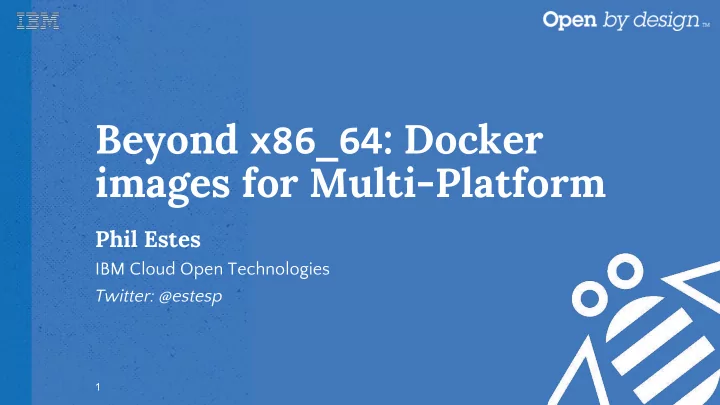

Beyond x86_64 : Docker images for Multi-Platform Phil Estes IBM Cloud Open Technologies Twitter: @estesp 1
About Me Phil Estes Senior Technical Staff Member IBM Cloud, Open Technologies Container Strategy/Open Source Leader Docker community core engine maintainer < Linux/open source expertise for 15 years @ IBM < Community activities & accomplishments > Brought user namespace support to the Docker engine > Helped design v2.2 image specification with multi-platform support > Implemented first tool to create multi-platform images in Docker v2.3 registry > Member of the “Docker Captains” program 2
Background: DockerCon Barcelona, Nov 2015 • Multi-platform support in registry via “ workarounds ”: • Repo-per-arch/platform: ppc64le/ , s390x/ , armv7/ • Image name prefixes: rpi- (rpi-node, rpi-consul, rpi-mysql) • Tag names with architecture detail: • multiarch/busybox :s390x • multiarch/busybox :amd64 • multiarch/busybox :armhf • Nearly finalized v2.2 image manifest specification: • PR #1068 defined the new specification format; proposed in Oct, agreed to and merged Dec. 18th, 2015 • PR #1281 implemented the new spec format in the registry (docker/distribution), and was merged on Jan. 7th, 2016 3
The manifest list Registry Object Type • How does the v2.2 image manifest spec support multi-platform? • Via a new registry manifest type: the manifest list • A manifest list contains pointers to existing manifest objects • A manifest list contains a platform specification associated with each pointer to an existing manifest • What is a platform specification? "platform": { // example with *all* fields Could be very simple: "architecture": "amd64", "os": "linux", "platform": { "os.version": "10.0.10586", "architecture": "ppc64le", "os.features": [ "os": "linux", "win32k" } ], "variant": "armv6l" "features": [ "sse4", "aes" ] 4 }
Docker 1.10: Engine Support • Docker 1.10 included rudimentary engine support for manifest list objects: • Engine checks manifest list entries against GOOS and GOARCH values from the Docker engine host platform • If a platform entry from the manifest list matches, that reference manifest is then pulled from the registry and used as that name:tag locally • Why rudimentary? • Is not (yet) using the feature or variant fields to make determinations against the local host platform/architecture • Potentially more important for embedded platforms than server-oriented platforms 5
Creating a Manifest List • Registry v2.3 and above support manifest lists • DockerHub now supports pushing manifest list objects • Open source “docker/distribution” v2.3 and above (this includes the official DockerHub “ registry ” image, now at v2.4.1) • Official tooling still under discussion • Discussion: Where does it fit? (e.g. extend “ docker push ”) • Details, details (how to specify inputs, image signing/trust, etc.) • Proof of concept tool available today for testing • https://github.com/estesp/manifest-tool • Can inspect (list) or push manifest lists to private registry or DockerHub • Read more about it here: https://integratedcode.us/2016/04/22/a-step-towards-multi-platform-docker-images/ 6
The Manifest Tool • Input: YAML definition of input images + platform specifications image: estesp/debian:jessie manifests: • image : target manifest list name:tag - • manifests : list of image names with image: s390x/debian:jessie platform: associated platform specification architecture: s390x os: linux • Architecture and OS fields validated - image: debian:jessie against known good values/combinations platform: • Image references are architecture: amd64 os: linux queried/validated; can reside in any - image: ppc64le/debian:jessie repo, but on the same registry host platform: architecture: ppc64le • Manifest list written to registry os: linux - image: aarch64/debian:jessie platform: architecture: arm64 os: linux 7 variant: armv8
Let’s Demo 8
What’s Left? • Engine: Full Support for ‘platform’ Definition • Windows will exploit os.version and os.features entries for full platform matching • Linux-based engines need to determine how to “understand” features and variant with standardized definitions (e.g. /proc/cpuinfo ) • Official tooling for manifest list push/inspection • Requires full support for Docker Content Trust/image signing • Content publishers/creators need to be informed of capabilities • DockerHub/UI Updates • Currently no visibility into “manifest list” entries • Platform information: a visual representation for consumers to find supported platforms for a given manifest list-based image • Workflow details (automated builds?) 9
Thank You! @estesp github.com/estesp estesp@gmail.com https://integratedcode.us IRC: estesp 10
Recommend
More recommend